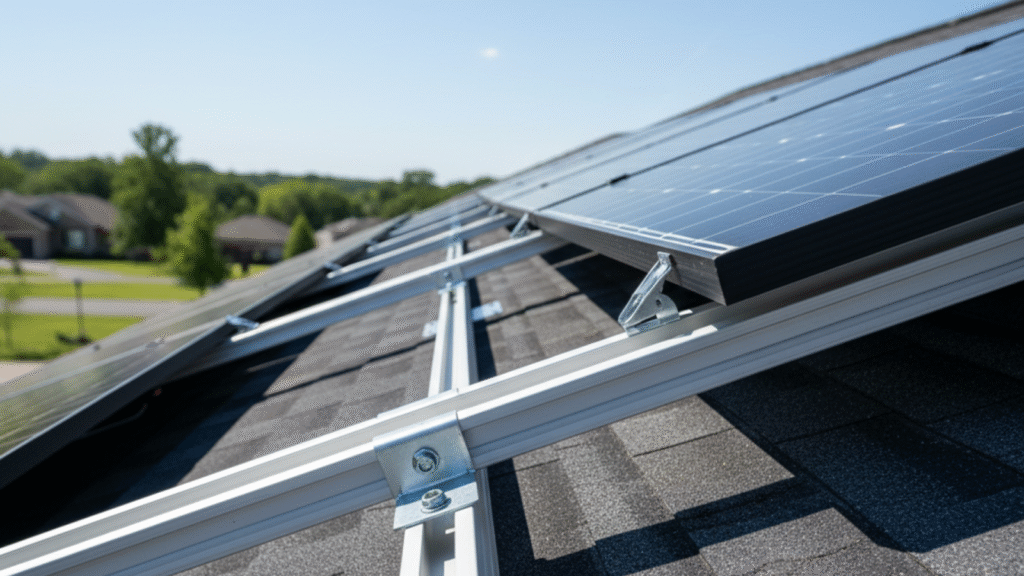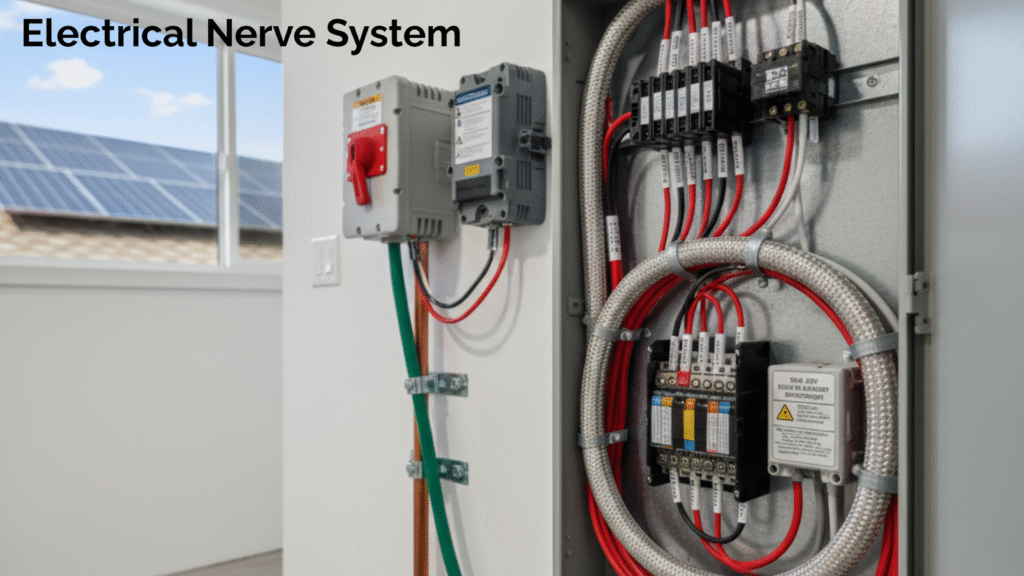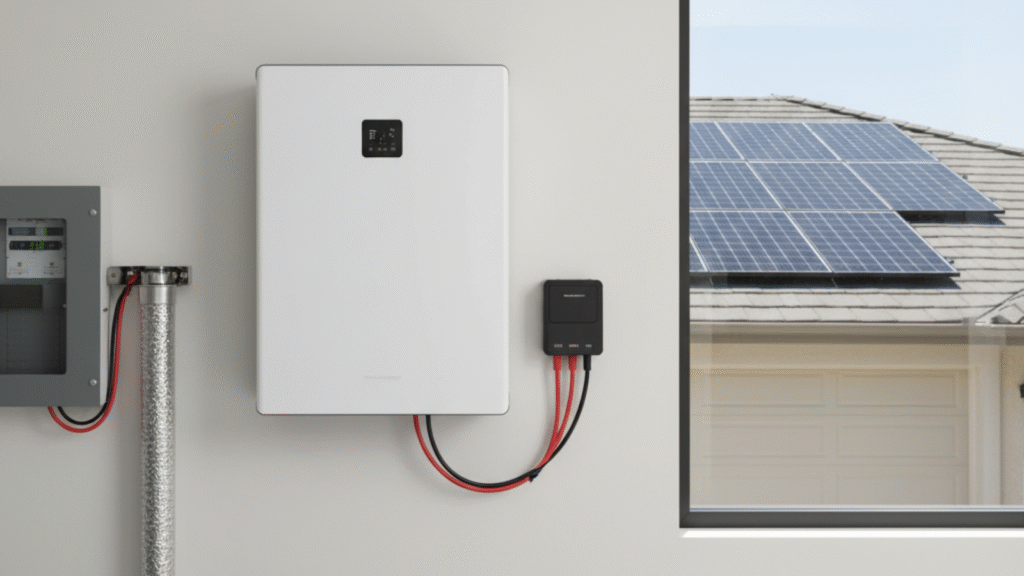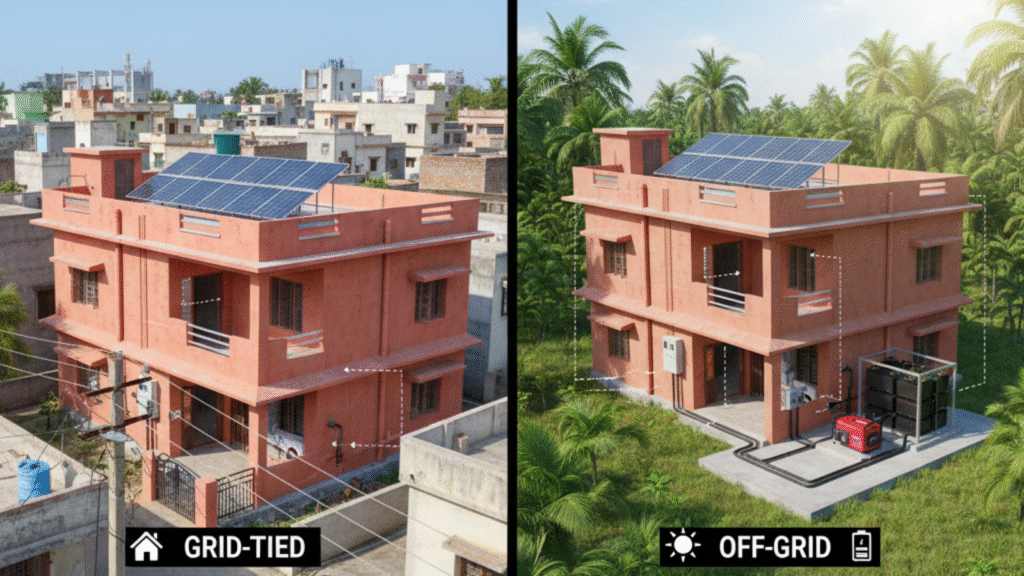
The decision to install a solar energy system is a powerful commitment to a sustainable and financially smart future. Yet, the journey often begins with a fundamental question: What exactly makes up a solar power system? While the panels on the roof are the face of solar, the true power lies in the intricate network of Solar Energy System Components working in concert.
This comprehensive guide pulls back the curtain on photovoltaic (PV) technology, detailing every essential component from the silicon cells that capture sunlight to the hardware that protects your investment. Understanding the function of each part is crucial to ensuring you invest in a system that is efficient, reliable, and perfectly tailored to your energy needs.
The Producers: Solar Photovoltaic (PV) Panels – Core Solar Energy System Components

The solar panels, or modules, are the visible workhorses of your system. They capture the sun’s energy and initiate the power conversion process—the very heart of the system.
How the Magic Happens: The Photovoltaic Effect
Each panel is composed of numerous smaller solar cells. These cells, typically made of silicon, are layered with conductive materials. When photons (particles of light) hit the silicon, they knock electrons loose, creating an electric current—this is the photovoltaic effect. The current generated is Direct Current (DC) electricity.
The Two Main Types of Solar Panels
Understanding the differences in panel technology is essential, as it affects efficiency, cost, and system size. For instance, efficiency is a primary consideration for residential systems.
- Monocrystalline Panels:
- Composition: Made from a single, high-purity silicon crystal.
- Efficiency: Highest efficiency rating (typically 18–22%) and a sleek, uniform dark color.
- Application: Ideal for smaller roofs or areas where space is limited and maximum power is required.
- Polycrystalline Panels:
- Composition: Made from fragments of silicon crystals melted together.
- Efficiency: Slightly lower efficiency (typically 15–17%) and a characteristic blue, speckled appearance.
- Application: More cost-effective to produce, making them a popular choice for large installations where space isn’t a constraint.
Anatomy of a Solar Module: Beyond the Cell
Beyond the silicon cell, the module itself is a robust structure:
- Glass Cover: A layer of tempered glass protects the cells from weather, dirt, and debris.
- Encapsulant: A layer of EVA (Ethylene Vinyl Acetate) seals the cells to prevent moisture ingress.
- Backsheet: A durable, weather-resistant layer on the back, often made of polymer, to protect the internal wiring.
- Aluminum Frame: Provides structural integrity, protects the edges, and facilitates easy mounting. All of these are critical solar energy system components.
The Brains: Solar Inverters and Optimizers – Essential Energy System Components

The electricity produced by your solar panels—DC power—cannot be used by standard home appliances, which require Alternating Current (AC) power. The inverter is the single most important electrical component, acting as the system’s “brain” and translator.
1. Central/String Inverters
This is the traditional inverter type. Panels are wired together in a “string,” and the combined DC output from the string is fed into a single, central inverter unit, typically mounted near the main electrical panel.
- Pros: Lower initial cost, simpler maintenance.
- Cons: “The Christmas Light Effect” can be an issue. If one panel is shaded or underperforming, it drags down the production of the entire string. Performance is therefore limited by the weakest panel in that group.
2. Microinverters
Instead of one central unit, a small microinverter is installed directly beneath each individual solar panel. It converts the DC power to AC power right at the source, making it one of the most efficient solar energy system components.
- Pros: Maximum Panel Performance. Each panel operates independently, eliminating the “Christmas light effect.” Excellent for complex rooflines or partial shading. Real-time monitoring for every panel is possible.
- Cons: Higher upfront cost and slightly more complex maintenance as units are on the roof.
3. Power Optimizers
This robust hybrid solution involves an optimizer attached to each panel. It conditions and tracks the maximum power point (MPP) of that specific panel. The power, however, remains DC and then travels to a small, central string inverter for the final DC-to-AC conversion.
- Pros: Combines the individual panel optimization benefits of microinverters with the simpler electronics of a string inverter. This offers a great middle ground for performance and cost.
The Foundation: Racking and Mounting Hardware

These often-overlooked Solar Energy System Components are critical for the safety, longevity, and optimal performance of the entire array. They secure the panels against everything from high-speed winds to heavy snow.
| Component | Description | Functionality & Importance |
| Rails | Long aluminum or steel tracks that run parallel to the roof. | Provides the structural framework upon which the panels are clamped. Must support the array’s total weight securely. |
| Clamps | Small metal brackets (mid-clamps and end-clamps). | Secure the solar panels firmly to the rails, ensuring they do not shift or blow away in extreme weather conditions. |
| Flashing & Footing | Waterproof metal plates and mounting bases. | Essential for roof-mounted systems. Ensures a waterproof seal where the mount penetrates the roof material. This prevents leaks and maintains roof integrity for decades. |
| Tilt Legs/Stands | Adjustable or fixed support structures. | Used to set the optimal tilt angle for ground-mounted systems or flat roofs to maximize year-round sun exposure and energy harvest. |
The quality of the racking system determines the structural integrity of your entire solar power system. Therefore, only high-grade materials like corrosion-resistant aluminum should be used for these crucial solar energy system components.
The Electrical Nerve System: Wiring and Safety Components of Every Solar System

The electrical hardware connects all the major Solar Energy System Components and ensures safe, compliant operation. These components are vital for system protection.
1. Wiring and Conduits
We use specialized PV Wire to connect the panels to each other and to the inverter. These cables are UV-resistant, rated for high temperatures, and designed to minimize energy loss. Conduits—plastic or metal tubing—protect the wiring from environmental damage and physical wear, ensuring reliable power flow.
2. Disconnect Switches (AC and DC)
These are manually operated switches required by code. They allow emergency responders or maintenance personnel to safely shut down the flow of electricity from the solar array and the grid. Quick and easy access to these disconnects remains a top safety priority.
3. Fuses and Breakers
Installed in electrical boxes (like the combiner box or main panel) to protect the equipment and wiring from overcurrents. They automatically trip or burn out to stop the current flow during a surge or short circuit, protecting your valuable equipment.
4. Grounding Equipment
A safety mechanism that provides a dedicated, low-resistance path for stray electrical current to dissipate into the earth, preventing electrical shock and damage from lighting strikes or faults. Proper grounding is non-negotiable for system safety.
The Storage Solution: Solar Batteries and Charge Controllers

For many homeowners, the ultimate goal is energy independence, or at least backup power during an outage. Consequently, energy storage has become a major focus.
1. Solar Battery (Energy Storage System – ESS)
The battery is a sophisticated device that stores the excess DC energy generated by the panels for later use.
- Primary Function: Provides power when the sun isn’t shining (at night) or when the utility grid goes down (backup power).
- Key Metrics: Capacity (how much energy it holds) and Power (how quickly it can deliver that energy).
- Types: Modern residential systems overwhelmingly use Lithium-Ion batteries (similar to those in EVs) due to their high efficiency, long cycle life, and compact size.
2. Charge Controller (For Off-Grid Systems)
In simple off-grid systems (and some battery-backup systems), the charge controller regulates the flow of current from the panels to the battery bank. Its job is to prevent overcharging and deep discharging, both of which can severely damage the battery’s lifespan. This component acts as a gatekeeper for the battery.
3. DC-Coupled vs. AC-Coupled Storage
The method of integrating the battery matters for overall efficiency:
- AC-Coupled: The main inverter converts the solar power to AC. Then, a separate, battery-specific inverter converts it back to DC for storage, and then back to AC again for home use. You can simply retrofit this configuration to an existing solar system.
- DC-Coupled: We connect the battery directly to the DC side of the main inverter. This is generally more efficient, as it avoids some conversion losses, but works best when you set up the entire system brand new.
Grid-Tied vs. Off-Grid: Comparing Solar System Components and Setup

The final configuration of the Solar Energy System Components depends entirely on the system type you choose. Each setup has unique requirements and benefits.
| System Type | Description | Key Components & Function |
| Grid-Tied | Connected to the local utility grid. Draws power when solar production is low and sends excess power back. | Panels, Inverter (String/Micro/Optimizer), Bi-directional Utility Meter (for Net Metering). This setup requires no battery. |
| Off-Grid | Entirely independent of the utility grid. All power comes from solar, and all excess must be stored for later use. | Panels, Inverter (often a pure sine wave), Charge Controller, Large Battery Bank. Often requires a backup generator for long cloudy periods. |
| Hybrid (Grid-Tied with Storage) | Connected to the grid but includes a battery for backup power and energy management. | Panels, Hybrid Inverter (handles both grid and battery power), Battery. This setup offers the best of both worlds: utility security and reliable backup power. |
Conclusion: The Interconnected Brilliance of Solar Energy System Components
The brilliance of a solar installation isn’t just the panel; it’s the seamless integration of all the Solar Energy System Components. From the microscopic silicon cells converting photons into DC power, to the sophisticated inverter translating that power to AC, and the heavy-duty racking securing it all—every component plays a vital and non-negotiable role. A single underperforming part can reduce the efficiency of the whole system.
When considering a switch to solar, focus on the quality and compatibility of these individual parts. A well-designed system, utilizing high-quality panels, an appropriate inverter, and robust mounting hardware, is the key to maximizing your energy production, securing your energy future, and achieving the fastest possible return on your investment. Ultimately, understanding the anatomy of these solar energy system components empowers you to make the most informed decision possible.
Frequently Asked Questions (FAQ) about Solar Energy System Components
Q1. What is the single most important component of a solar energy system?
A. The most critical component is the Solar Inverter. While the panels produce raw DC power, the inverter converts it into usable AC power for your home and the grid. Its performance directly controls how much solar energy you can actually use.
Q2. What is Net Metering and what component is involved?
A. Net Metering is a utility billing system. It credits you for excess solar electricity that you send back to the grid. A special Bi-directional Utility Meter manages this process. It accurately tracks the energy flowing both into and out of your home.
Q3. How long do the major parts of a solar system typically last?
A. Solar panels are built for longevity, often lasting 25 to 30 years (with a 25-year performance warranty). In contrast, the high-stress electronics of central string inverters typically need replacement after 10 to 15 years, while microinverters last longer, often 20 to 25 years.
Q4. Is a solar battery required for a home solar energy system?
A. No, you do not need a battery for a typical grid-tied system. Most homeowners remain connected to the utility grid and use that connection for instantaneous power and crediting. You only require a battery if your primary goal is backup power during a blackout or if you install a totally off-grid system.
Q5. How should I choose the right solar system components?
A. Component selection should depend on your site conditions. If your roof experiences partial shading, choose advanced components like Microinverters or Power Optimizers for better performance. For a simple, unshaded roof, a standard String Inverter is usually the more cost-effective choice. Always consult a certified installer.

